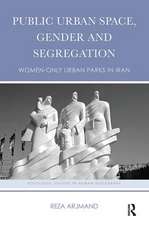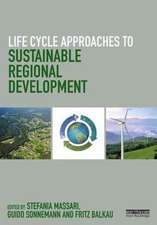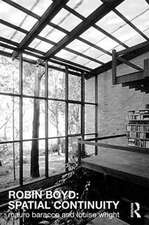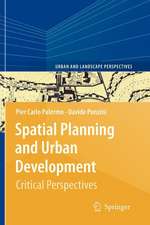Transnational Architecture and Urbanism: Rethinking How Cities Plan, Transform, and Learn: Routledge Research in Planning and Urban Design
Autor Davide Ponzinien Limba Engleză Hardback – 2 iun 2020
Since the 1990s, increasingly multinational modes of design have arisen, especially concerning prominent buildings and places. Traditional planning and design disciplines have proven to have limited comprehension of, and little grip on, such transformations. Public and scholarly discussions argue that these projects and transformations derive from socioeconomic, political, cultural trends or conditions of globalization. The author suggests that general urban theories are relevant as background, but of limited efficacy when dealing with such context-bound projects and policies.
This book critically investigates emerging problematic issues such as the spectacularization of the urban environment, the decontextualization of design practice, and the global circulation of plans and projects. The book portends new conceptualizations, evidence-based explanations, and practical understanding for architects, planners, and policy makers to critically learn from practice, to cope with these transnational issues, and to put better planning in place.
| Toate formatele și edițiile | Preț | Express |
|---|---|---|
| Paperback (1) | 369.95 lei 6-8 săpt. | |
| Taylor & Francis – 21 ian 2023 | 369.95 lei 6-8 săpt. | |
| Hardback (1) | 1000.27 lei 6-8 săpt. | |
| Taylor & Francis – 2 iun 2020 | 1000.27 lei 6-8 săpt. |
Din seria Routledge Research in Planning and Urban Design
-
 Preț: 327.98 lei
Preț: 327.98 lei -
 Preț: 292.40 lei
Preț: 292.40 lei -
 Preț: 294.82 lei
Preț: 294.82 lei -
 Preț: 311.41 lei
Preț: 311.41 lei -
 Preț: 154.17 lei
Preț: 154.17 lei -
 Preț: 348.21 lei
Preț: 348.21 lei -
 Preț: 311.41 lei
Preț: 311.41 lei -
 Preț: 317.06 lei
Preț: 317.06 lei -
 Preț: 340.99 lei
Preț: 340.99 lei - 31%
 Preț: 763.39 lei
Preț: 763.39 lei - 31%
 Preț: 764.20 lei
Preț: 764.20 lei - 26%
 Preț: 875.97 lei
Preț: 875.97 lei - 26%
 Preț: 846.50 lei
Preț: 846.50 lei - 18%
 Preț: 1005.01 lei
Preț: 1005.01 lei - 18%
 Preț: 1216.52 lei
Preț: 1216.52 lei - 14%
 Preț: 338.33 lei
Preț: 338.33 lei -
 Preț: 284.52 lei
Preț: 284.52 lei -
 Preț: 469.34 lei
Preț: 469.34 lei -
 Preț: 489.26 lei
Preț: 489.26 lei -
 Preț: 449.41 lei
Preț: 449.41 lei - 28%
 Preț: 823.59 lei
Preț: 823.59 lei -
 Preț: 449.41 lei
Preț: 449.41 lei - 25%
 Preț: 569.79 lei
Preț: 569.79 lei - 25%
 Preț: 767.88 lei
Preț: 767.88 lei - 24%
 Preț: 324.16 lei
Preț: 324.16 lei - 18%
 Preț: 1106.02 lei
Preț: 1106.02 lei - 26%
 Preț: 766.10 lei
Preț: 766.10 lei - 18%
 Preț: 1161.28 lei
Preț: 1161.28 lei - 18%
 Preț: 1000.27 lei
Preț: 1000.27 lei - 26%
 Preț: 819.91 lei
Preț: 819.91 lei - 18%
 Preț: 1000.13 lei
Preț: 1000.13 lei -
 Preț: 436.14 lei
Preț: 436.14 lei - 18%
 Preț: 1001.24 lei
Preț: 1001.24 lei - 27%
 Preț: 554.64 lei
Preț: 554.64 lei - 26%
 Preț: 764.20 lei
Preț: 764.20 lei - 28%
 Preț: 822.76 lei
Preț: 822.76 lei - 18%
 Preț: 1160.32 lei
Preț: 1160.32 lei - 18%
 Preț: 1000.76 lei
Preț: 1000.76 lei - 28%
 Preț: 847.34 lei
Preț: 847.34 lei - 25%
 Preț: 852.63 lei
Preț: 852.63 lei - 18%
 Preț: 1169.16 lei
Preț: 1169.16 lei - 18%
 Preț: 1111.90 lei
Preț: 1111.90 lei - 18%
 Preț: 1107.61 lei
Preț: 1107.61 lei
Preț: 1000.27 lei
Preț vechi: 1219.84 lei
-18% Nou
Puncte Express: 1500
Preț estimativ în valută:
191.46€ • 208.04$ • 160.93£
191.46€ • 208.04$ • 160.93£
Carte tipărită la comandă
Livrare economică 21 aprilie-05 mai
Preluare comenzi: 021 569.72.76
Specificații
ISBN-13: 9780415787925
ISBN-10: 0415787920
Pagini: 320
Ilustrații: 85
Dimensiuni: 156 x 234 x 23 mm
Greutate: 0.45 kg
Ediția:1
Editura: Taylor & Francis
Colecția Routledge
Seria Routledge Research in Planning and Urban Design
Locul publicării:Oxford, United Kingdom
ISBN-10: 0415787920
Pagini: 320
Ilustrații: 85
Dimensiuni: 156 x 234 x 23 mm
Greutate: 0.45 kg
Ediția:1
Editura: Taylor & Francis
Colecția Routledge
Seria Routledge Research in Planning and Urban Design
Locul publicării:Oxford, United Kingdom
Public țintă
PostgraduateCuprins
List of figures
List of tables
Introduction
PART I – Transnational architecture and urbanism
1 The transnational transformations of contemporary cities
1.1 Ubiquitous and homogenizing forces of urban globalization?
1.2 Global spread and local transplants: past and recent examples
1.3 Contemporary urban narratives, models and projects
1.4 City forms and transnational projects: pressing issues and questions
2 Looking for (urban) troubles across disciplines
2.1 The architecture/city nexus: old criticisms and contemporary reductions to absurdity
2.2 Forms of contemporary urban development: Manhattanism, bigness and the generic post-metropolis
2.3 Glocal urban competition and growth machines
2.4 Contemporary architectural and urban knowledge is part of the problem
3 A Conceptual framework for usable knowledge in contemporary cities
3.1 Projects and built forms
3.2 Glocal places and contexts
3.3 Transnational agents and networks
3.4 Transnational urban processes
3.5 Analyzing transnational projects through their mobilities, circulation, and transfer
3.6 A conceptual framework for usable knowledge, not for general urban theories
4 Critical approach and pragmatic attitude
4.1 Long-term global mapping and urban analysis: forms, agents and process
4.2 The case study method and its limits in investigating transnational issues
4.3 Methods for critically understanding transnational architecture and urbanism
PART II – Critical issues
5 Spectacularization of contemporary architecture and the urban environment
5.1 Architecture in the society of spectacle
5.2 Urban politics and the economies of spectacle
5.3 Transnational cultural facilities and their urban expectations: the Guggenheim spectacles
5.4 The city wonders in the world: supertall skyscrapers
5.5 The Burj Khalifa in Downtown Dubai and beyond
5.6 Placing urban spectacles
6 Urban personification and the mobilities of global experts
6.1 Archistars, urbanistars and other transnational elites
6.2 The "New York by Gehry" building and other personifications
6.3 Hadid’s, Libeskind’s and Isozaki’s projects and the poor planning of Milan’s CityLife
6.4 Mobilities of urbanistars and planning consultancy groups
6.5 Transnational experts and local landings
7 Decontextualization of architectural and urban design
7.1 Economic and symbolic competitions in a financialized urban world
7.2 Transnational design firms’ strategies in contemporary cities
7.3 The transnational trajectories of Broadway Malyan’s firm and projects
7.4 Transnational urban development and the disconnect of its design
8 Plan circulation and complex transfers
8.1 New York’s High Line Elevated Park and its transnational circulation
8.2 The circulation of a master plan from Vancouver’s False Creek to Dubai Marina and beyond
8.3 Transferring an urban complex: from Abu Dhabi’s Central Market to Abu Dhabi Plaza in Astana
9 Transfer of megastructures and buildings
9.1 Singapore’s new landmark transferred to Chongqing
9.2 From Barcelona’s Poblenou to Doha’s West Bay: the take-off and landing of an iconic skyscraper
9.3 Understanding the qualities of transnational places and projects
10 Homogenization of central places and urban landscapes
10.1 Homogenization in contemporary cities
10.2 Five ways of comprehending urban homogenization
10.3 Transnational geographies and dynamics of urban homogenization
PART III – Conclusions
11 Planning, learning and dealing with transnational architecture and urbanism
11.1 Varied relevance of local planning and the legitimization crisis of urban and design knowledge
11.2 A state of unlearning: speed, scale and de-politicization of urban planning and architectural design
11.3 The little room for maneuvering and for making better places
12 How can urban planners, designers and policy makers cope with these issues?
12.1 Contextual learning from transnational plans and projects
12.2 Less about transnational narratives, more about local problems
12.3 Critical paths for research and practice across urban design, planning and policy making
References
Indexes
List of tables
Introduction
PART I – Transnational architecture and urbanism
1 The transnational transformations of contemporary cities
1.1 Ubiquitous and homogenizing forces of urban globalization?
1.2 Global spread and local transplants: past and recent examples
1.3 Contemporary urban narratives, models and projects
1.4 City forms and transnational projects: pressing issues and questions
2 Looking for (urban) troubles across disciplines
2.1 The architecture/city nexus: old criticisms and contemporary reductions to absurdity
2.2 Forms of contemporary urban development: Manhattanism, bigness and the generic post-metropolis
2.3 Glocal urban competition and growth machines
2.4 Contemporary architectural and urban knowledge is part of the problem
3 A Conceptual framework for usable knowledge in contemporary cities
3.1 Projects and built forms
3.2 Glocal places and contexts
3.3 Transnational agents and networks
3.4 Transnational urban processes
3.5 Analyzing transnational projects through their mobilities, circulation, and transfer
3.6 A conceptual framework for usable knowledge, not for general urban theories
4 Critical approach and pragmatic attitude
4.1 Long-term global mapping and urban analysis: forms, agents and process
4.2 The case study method and its limits in investigating transnational issues
4.3 Methods for critically understanding transnational architecture and urbanism
PART II – Critical issues
5 Spectacularization of contemporary architecture and the urban environment
5.1 Architecture in the society of spectacle
5.2 Urban politics and the economies of spectacle
5.3 Transnational cultural facilities and their urban expectations: the Guggenheim spectacles
5.4 The city wonders in the world: supertall skyscrapers
5.5 The Burj Khalifa in Downtown Dubai and beyond
5.6 Placing urban spectacles
6 Urban personification and the mobilities of global experts
6.1 Archistars, urbanistars and other transnational elites
6.2 The "New York by Gehry" building and other personifications
6.3 Hadid’s, Libeskind’s and Isozaki’s projects and the poor planning of Milan’s CityLife
6.4 Mobilities of urbanistars and planning consultancy groups
6.5 Transnational experts and local landings
7 Decontextualization of architectural and urban design
7.1 Economic and symbolic competitions in a financialized urban world
7.2 Transnational design firms’ strategies in contemporary cities
7.3 The transnational trajectories of Broadway Malyan’s firm and projects
7.4 Transnational urban development and the disconnect of its design
8 Plan circulation and complex transfers
8.1 New York’s High Line Elevated Park and its transnational circulation
8.2 The circulation of a master plan from Vancouver’s False Creek to Dubai Marina and beyond
8.3 Transferring an urban complex: from Abu Dhabi’s Central Market to Abu Dhabi Plaza in Astana
9 Transfer of megastructures and buildings
9.1 Singapore’s new landmark transferred to Chongqing
9.2 From Barcelona’s Poblenou to Doha’s West Bay: the take-off and landing of an iconic skyscraper
9.3 Understanding the qualities of transnational places and projects
10 Homogenization of central places and urban landscapes
10.1 Homogenization in contemporary cities
10.2 Five ways of comprehending urban homogenization
10.3 Transnational geographies and dynamics of urban homogenization
PART III – Conclusions
11 Planning, learning and dealing with transnational architecture and urbanism
11.1 Varied relevance of local planning and the legitimization crisis of urban and design knowledge
11.2 A state of unlearning: speed, scale and de-politicization of urban planning and architectural design
11.3 The little room for maneuvering and for making better places
12 How can urban planners, designers and policy makers cope with these issues?
12.1 Contextual learning from transnational plans and projects
12.2 Less about transnational narratives, more about local problems
12.3 Critical paths for research and practice across urban design, planning and policy making
References
Indexes
Notă biografică
Davide Ponzini is Associate Professor of Urban Planning at Politecnico di Milano. He has also been a visiting scholar at Yale, Johns Hopkins, Columbia University, and Sciences Po Paris and Visiting Professor at TU Munich. His research activity focuses on planning theory, urban and cultural policy, and contemporary architecture. He is co-author (with the photographer Michele Nastasi) of Starchitecture, and co-editor (with Harvey Molotch) of The New Arab Urban: Gulf Cities of Wealth, Ambition, and Distress.
Recenzii
"Critical urban scholarship at its best, Transnational Architecture and Urbanism is a thoughtful and balanced approach – deeply embedded in the literature and replete with examples – to the transnational flows of ideas about cities and buildings. This is urban theory as it is meant to be written."
Robert Beauregard, Professor Emeritus, Columbia University
"The subtitle of this book isRethinking How Contemporary Cities Plan, Transform and Learn,and this is exactly what it delivers. A tight conceptual framework effectively organises a critical analysis of the ubiquitous and homogenizing forces of urban globalization through a series of case studies. Ponzini’s conclusion that ‘contextual learning’ by architects and urban planners, focusing less on the global (though not ignoring it) and more on the local, presents a timely and formidable challenge to the whole community of urbanists and architects who build in cities. With its rich complement of images, this book achieves that unusual but much sought after goal - a text that students, academic researchers, professionals, and indeed anyone interested in cities will find informative, intellectually provocative, visually exciting, and readable."
Leslie Sklair, London School of Economics
Robert Beauregard, Professor Emeritus, Columbia University
"The subtitle of this book isRethinking How Contemporary Cities Plan, Transform and Learn,and this is exactly what it delivers. A tight conceptual framework effectively organises a critical analysis of the ubiquitous and homogenizing forces of urban globalization through a series of case studies. Ponzini’s conclusion that ‘contextual learning’ by architects and urban planners, focusing less on the global (though not ignoring it) and more on the local, presents a timely and formidable challenge to the whole community of urbanists and architects who build in cities. With its rich complement of images, this book achieves that unusual but much sought after goal - a text that students, academic researchers, professionals, and indeed anyone interested in cities will find informative, intellectually provocative, visually exciting, and readable."
Leslie Sklair, London School of Economics
Descriere
Transnational Architecture and Urbanism combines urban planning, design, policy, and geography studies to offer place-based and project-oriented insight into relevant case studies of urban transformation in Europe, North America, Asia, and the Middle East.























